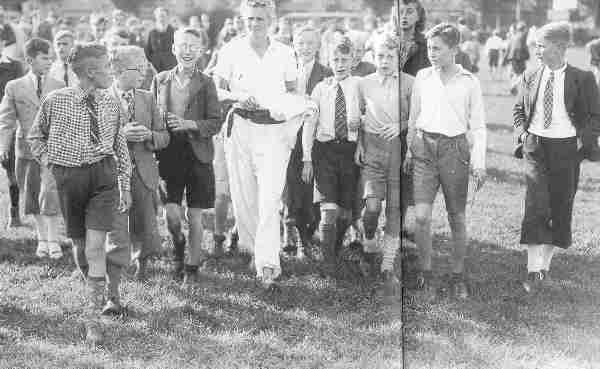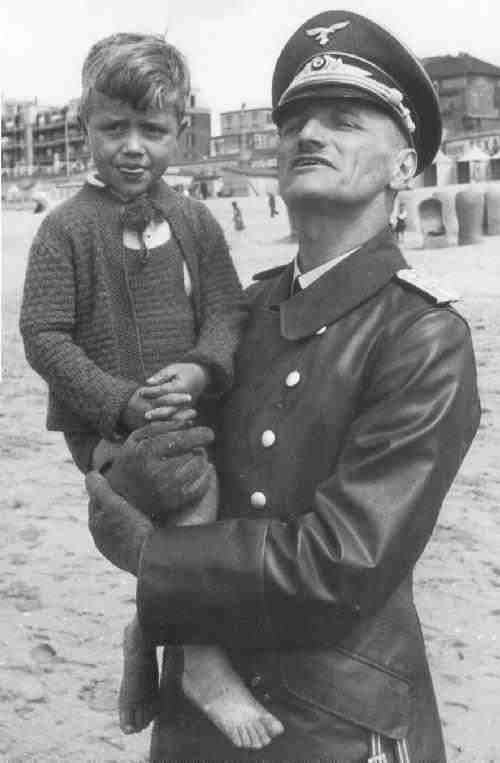
Dutch Boys' Clothes: Chronology--Inter-War and War Years (1940-45)

Figure 1.--These boys appear to be following an athelete after a spring athletic event--perhaps a cricket match. The photograph was taken in 1943. The boys appear to be about 12-14 years old and wear a variety of short pants and knicker suits. Note that the boys smartly dressed in actual suits all seem to be wearing knicker suits.
|
HBC believes that fashion essentially stood still during the World War II occupation of the Netherlands by the Germans. Boys appear to have continue wearing rather much the styles of the late 1930s. I do not know if the Germans introduced any new styles in the early 1940s. Presunably German styles were already common. Dutch boys may have been willing to wear German styles when in 1940-41 it looked like the German were the wave of the future. Later in the War boys may have been motivated to reject German styles, although clothing must have been very sacrce in 1944-45. Boys commonly wore short pants suits, although some younger teenagers had knicker suits. Long pants suits were not very common--except for younger boys. Some boys wore sandals--but they were not very common for boys once they reached the teen years. Some limited information is avaialbale on this period.
Chronology
HBC believes that fashion essentially stood still during the World War II occupation of the Netherlands by the Germans. The Germans invaded the Nethers land in May 1940. Neutral Netherlands was the first country seized by the Germans in their campaign in the West. The terror bombing of Rotterdam shocked the world. The Dutch were totally demoralized. Most assumed the War was lost and there was no hope of liberation. Boys appear to have continued wearing rather much the styles of the late 1930s. HBC at this time knows of no important new styles which developed during the War years. Conditions worsened severly in 1944. Allied troops after the Normandy invasion reached the Dutch border by September 1944. The British attempted to liberate the Netherlands in the fall of 1944, but were stopped by the Germans at Arnehm. Much of the Netheralnds was not liberated until Spring 1945. Boys during the occupation. By the time the Allies arrived, the Dutch were near starvation. Clothing was very sacrce in 1944-45 and boys probably wore what ever they had. I doubt if a lot of new purchases were possible for most boys.

Figure 2.--The Germans regarded the Dutch as fellow Aryans which affected their occupation policies. This photographbwas taken in 1940 just after the Germans had occupied the Netherlands. Most Germans at the time, like this Luftwaffe officer, thought that they had essentially won the War. Note the knit outfit theboy is wearing.
|
Life During the Occupation
Many available photographs of Dutch boys diring the occupation period suggest an air of normalacy. As long as the family was not Jewish, the German occupation was much more benign than was the case in of conyties like Poland and the Soviet Union. Race was an important factor in German occupation policy and the Germans viewed the Dutch as fellow Arayans. Thus while economic conditions began deteriorating in 1943, in many ways personal lives were not as affected as in many other countries. Schools continued to function. The Germans attempted to ban Scouting which had been popular among Dutch boys, but did not employ draconian measures--although adults involved could be arrested.
Fashion Influences
I do not know if the Germans introduced any new styles in the early 1940s. Presunably German styles were already common. Dutch boys may have been willing to wear German styles when in 1940-41 it looked like the German were the wave of the future. Later in the War as it became increasingly clear tht the Germans were losing the Wat, boys may have been motivated to reject German styles.
Garments
Boys commonly wore short pants suits, although increasingkly younger teenagers wore knicker suits. Long pants suits were not very common--except for younger boys. Some boys wore sandals--but they were not very common for boys once they reached the teen years. Some limited information is available on this period. Note that all of the knicker suits have well below the knee knickers--a style that passed out of fashion in the America several years earlier.
for decades.
Styles
Few boys seem to have worn sailor suits by the 1940s. Younger boys commonly wore the knit outfits that began to appear in the 1920s. The boy here appears to be wearing a knitted swimsuit with a knitted top. They are on the beach and the boy has sand on
his feet. HBC has assumed that the knitted outfirs were wool. But a wool bathing suit doesn't seem very practical. Wouldn't the wool shrink? He is a young boy, perhaps he was just going to play in the sand. But it does not seem that a wool suit would be scratchy and not very comfortable.
Christopher Wagner

Navigate the Boys' Historical Clothing Web Site:
[Introduction]
[Activities]
[Bibliographies]
[Biographies]
[Chronology]
[Clothing styles]
[Contributions]
[Countries]
[Boys' Clothing Home]
Navigate the Boys' Historical Clothing Dutch pages:
[Maiken Island]
[Dutch choirs]
[Dutch scouts]
[Dutch school uniform]
[Dutch boys bangs]
Navigate the Boys' Historical Clothing national pages:
[Return to the Main Dutch inter-war and war years chronological page]
[Return to the Main Dutch chronological page]
[Return to the Main Dutch page]
[Australia]
[Belgium]
[England]
[France]
[Germany]
[Ireland]
[Italy]
[Japan]
[Korea]
[Mexico]
[Scotland]
[United States]
Created: March 13, 2001
Last updated: March 13, 2001




